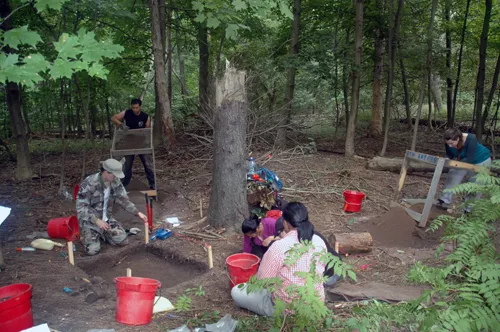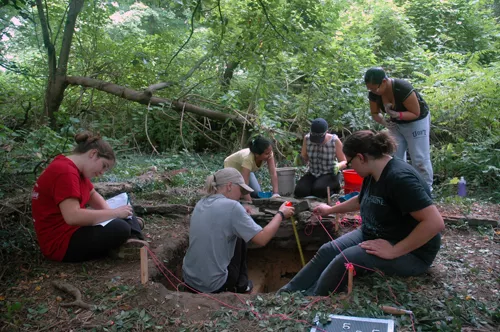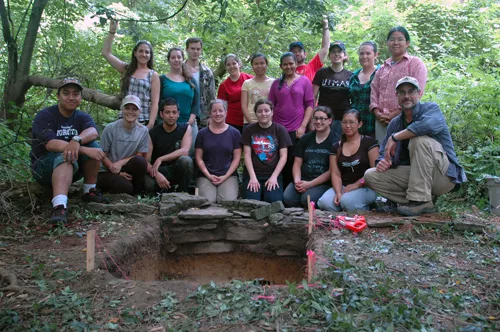
Digging history
Clad in sweatpants, T-shirts and gloves and coated with insect repellant, 15 University of Toronto Mississauga students spent two weeks this summer digging in the dirt on campus, earning course credit for their efforts.
The students, most entering the third year, were participants in UTM’s historical archaeology field school, part of the Anthropology 318 course that gives them an opportunity to apply their classroom knowledge in the field. This Department of Anthropology field school is generally held in alternate summers at sites around Ontario; this year’s edition was unique, because, for the first time, it took place on the UTM campus. The students learned field methods while unearthing the history of the campus itself.

“I didn’t expect so much history 50 metres to the right of Lislehurst,” said Francis Tran, a fourth-year anthropology specialist, as he marked down the coordinates of the plot his classmates were digging. “It’s right next to the trail and I walk on the trail all the time.”
Brand said the archaeology project will determine if the stones and bricks found on the site mark Woodham’s foundation or are the work of the subsequent owner. It will also explore how the original owners changed the landscape, adding plants reminiscent of their native England and elsewhere. He and his colleagues hope to collect a significant amount of data by 2017, UTM’s 50th anniversary.
“We’re in the testing phase,” said Brand. “We’ll open the site up enough to determine if it was the house or not and then understand the organization of space within it.
“I want the students to think about what they’re excavating and what it all means.”
This summer’s field school began with a week of morning classes and afternoon practice in basic field archaeology: mapping, pedestrian surveys and subsurface tests. The second week was devoted entirely to field work. The students mapped a grid that can be replicated, then explored selected squares throughout the grid in detail. After plotting the squares, they carefully dug down 10 centimetres at a time, sifting the excavated soil for artifacts that they will clean and number when their course continues this fall.
As they worked, Brand also ensured that the students became skilled in the tools of the archaeology trade.
“I try to set them up with the basic methods used in site surveys, because if they get jobs in the field after graduation, they will probably be doing surveys of sites proposed as building sites,” he said.

“I didn’t even know this place existed or had this kind of history,” said Alexandra Wheatcroft, a third-year anthropology specialist. “And I didn’t know about all the mapping techniques and how much planning goes into it before you get set to dig. Digging, by contrast, is so easy.”
Easy, yet especially rewarding when artifacts that will add to knowledge about the site are uncovered.
“I came across a metal shell from a 16-gauge shotgun,” said Wheatcroft. “It was my proudest moment.”
